This section jumps into detailed results from the High Electric Case of the transportation study.
Information can be found here about how the model was developed and set up for case studies. Key model findings and high-level summary can be found here. Unless otherwise specified, the results shown are for the region as a whole.
The results of the three model cases were evaluated for:
- Fuel consumption
- Electrification: electric vehicle sales, stock, and demand for electricity
- Hydrogen demand: fuel cell vehicles and the indirect electricity requirements to produce hydrogen via electrolysis
- Vehicle tailpipe emissions[1]
An additional dataset with results for this case is available TPT_ModelResults_HiElectric_Case.xlsx.
Roadway Transportation Mode Categories
| Category Name | Description | Weight |
| LDV | Light duty vehicles such as passenger cars, mini vans, sport utility vans, and small pickup trucks | < 8,500 lbs. |
| HDV Light | Commercial light trucks, Class 2 | 8,500 to 10,000 lbs. |
| HDV Med | Larger trucks, Class 3 through 6 | 10,000 to 26,000 lbs. |
| HDV Heavy | Freight trucks, Class 7 and higher | > 26,000 lbs. |
| Bus | Transit and School |
Transportation Vehicle Fuel Options
| Fuel | LDV | HDV Light | HDV Med | HDV Heavy | Bus |
| Gasoline | X | X | X | X | X |
| Diesel | X | X | X | X | X |
| Natural Gas | X | X | |||
| Direct Electricity | X | X[2] | X | ||
| Hydrogen | X[3] | X[3] |
The High Electric Case forces a more aggressive transition to electric vehicles in the LDV category, along with more electric buses, and an initial turn toward electrification of the HDV Light category (such as delivery trucks and vans).
Fuel Consumption
Consistent with the Reference Case, much of the roadway transportation in the region is powered by petroleum-based fuels at the start of the time horizon. However, with electrification, the fuel consumption of petroleum products declines by 9%. Most of the drop is coming from LDV gasoline use, which declines by 40%. Diesel-fuel use still grows substantially due to the HDV categories dependance on diesel.
Annual Fuel Consumption – High Electric Case
| Fuel | Units | 2020 | 2025 | 2030 | 2035 | 2040 | 2045 |
| Gasoline | Million Gallons | 5,436 | 5,399 | 4,973 | 4,379 | 3,774 | 3,256 |
| Diesel | Million Gallons | 2,578 | 2,793 | 3,038 | 3,325 | 3,649 | 4,053 |
| Natural Gas | Tbtu | 35 | 36 | 35 | 32 | 28 | 24 |
| Direct Electricity | GWh | 555 | 2,910 | 10,917 | 21,685 | 33,036 | 43,396 |
| Hydrogen | kTonne H2 | 0 | 0 | 0 | 0 | 0 | 0 |
Electrification
For this case, sales of electric vehicles in the LDV category are modeled to increase along a much steeper trajectory than the Reference Case, especially for the states of Oregon and Washington which may be influenced by state policy regarding electric vehicles. The following tables display the percent of sales and stock that are electric for the case.
Market Share of Electric Vehicle Sales in LDV Category - High Electric Case
| Region | Market Share | 2020 | 2025 | 2030 | 2035 | 2040 | 2045 |
| ID | % Sales Electric | 1.3 | 6.9 | 30.0 | 71.8 | 94.0 | 99.7 |
| MT | % Sales Electric | 2.0 | 10.6 | 40.7 | 80.4 | 96.0 | 99.5 |
| OR | % Sales Electric | 5.8 | 37.3 | 86.2 | 99.7 | 99.7 | 99.7 |
| WA | % Sales Electric | 6.4 | 39.6 | 99.7 | 99.7 | 99.7 | 99.7 |
| Total | % Sales Electric | 5.3 | 33.0 | 83.4 | 94.5 | 98.6 | 99.6 |
Percent of Electric Vehicle Stock in LDV Category - High Electric Case
| Region | Market Share | 2020 | 2025 | 2030 | 2035 | 2040 | 2045 |
| ID | % Stock Electric | 0.2 | 0.9 | 4.5 | 14.9 | 29.8 | 43.6 |
| MT | % Stock Electric | 0.2 | 1.1 | 5.6 | 16.4 | 29.7 | 41.7 |
| OR | % Stock Electric | 0.9 | 4.8 | 17.1 | 32.0 | 44.5 | 54.5 |
| WA | % Stock Electric | 0.9 | 5.1 | 19.4 | 35.0 | 47.3 | 57.1 |
| Total | % Stock Electric | 0.8 | 4.3 | 15.9 | 30.4 | 43.1 | 53.7 |
The next two figures show annual units of electric vehicle sales and stock, by state for the LDV category.
Annual LDV Electric Vehicle Sales by State – High Electric Case
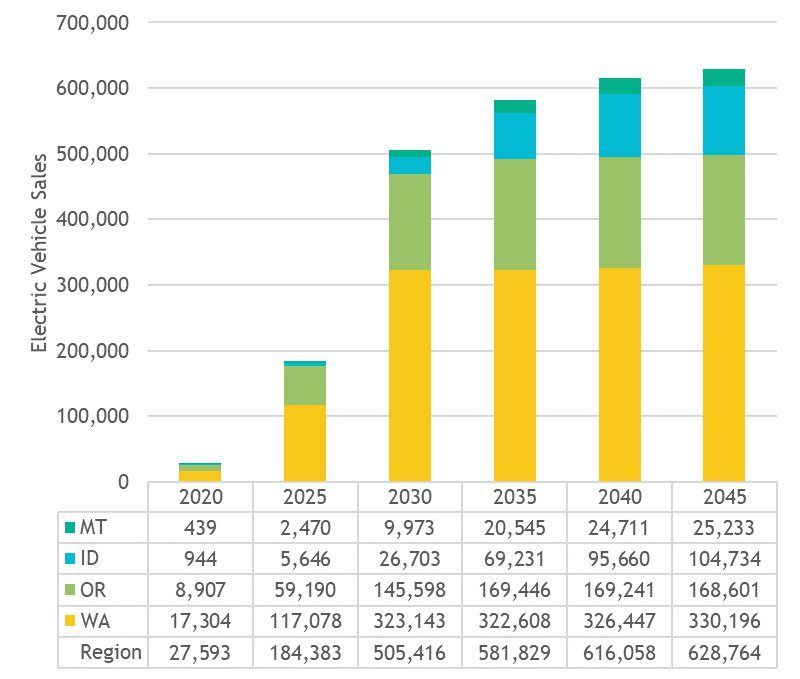
Annual LDV Electric Vehicle Stock by State – High Electric Case
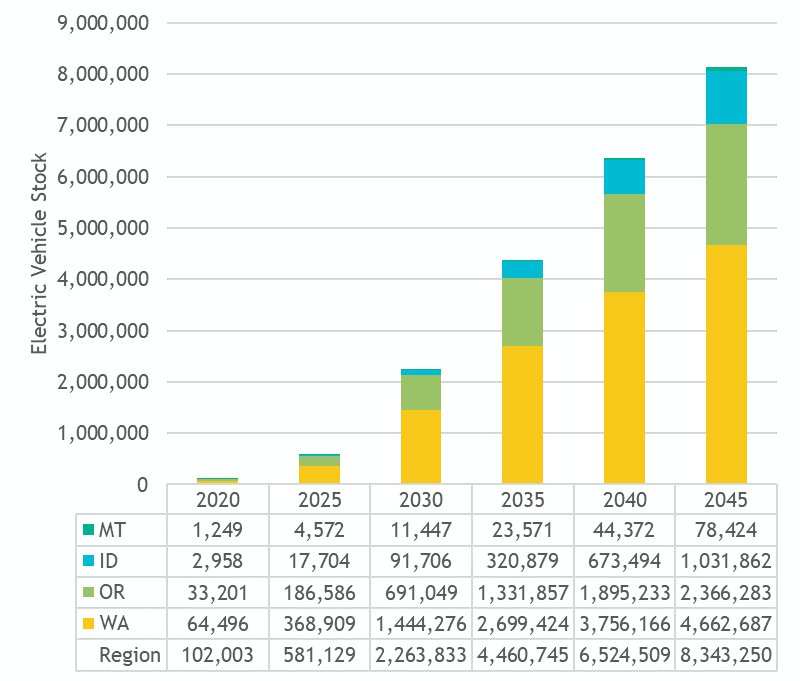
In the HDV Light category, gasoline and diesel are the primary fuels for moving goods at the beginning of the time horizon. Direct electric transport is modeled to be phased in over time and replaces the goods moved with petroleum-based fuels.
Percentage of Vehicle Ton-Miles Traveled by Fuel Type HDV Light – High Electric Case
| Fuel | Units | 2020 | 2025 | 2030 | 2035 | 2040 | 2045 |
| Gasoline | % | 58 | 59 | 60 | 54 | 36 | 18 |
| Diesel | % | 42 | 40 | 38 | 34 | 22 | 11 |
| Electric | % | 0 | 0 | 2 | 12 | 41 | 70 |
The direct electrification of transportation is spread across three vehicle categories, but much of the demand for electricity remains concentrated in the LDV category.
Annual Electricity Demand by Category – High Electric Case
| Category | Units | 2020 | 2025 | 2030 | 2035 | 2040 | 2045 |
| LDV | GWh | 553 | 2,899 | 10,789 | 20,734 | 29,616 | 36,985 |
| HDV Light | GWh | 0 | 7 | 104 | 806 | 3,038 | 5,774 |
| Bus | GWh | 2 | 4 | 24 | 145 | 382 | 638 |
| Total | GWh | 555 | 2,910 | 10,917 | 21,685 | 33,036 | 43,396 |
Annual Electricity Demand by State – High Electric Case
| Region | Units | 2020 | 2025 | 2030 | 2035 | 2040 | 2045 |
| ID | GWh | 17 | 94 | 466 | 1,614 | 3,495 | 5,592 |
| MT | GWh | 7 | 35 | 155 | 453 | 856 | 1,261 |
| OR | GWh | 186 | 962 | 3,432 | 6,631 | 9,680 | 12,188 |
| WA | GWh | 345 | 1,818 | 6,864 | 12,987 | 19,004 | 24,355 |
| Total | GWh | 555 | 2,910 | 10,917 | 21,685 | 33,036 | 43,396 |
Annual LDV Electric Vehicle Electricity Demand by State – High Electric Case
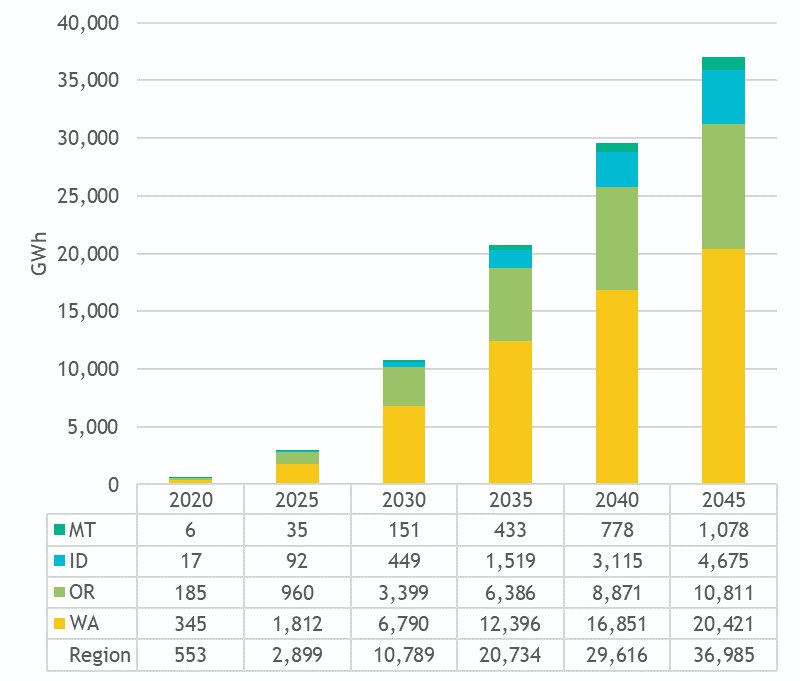
Tailpipe Emissions
With the additional electrification reducing petroleum fuel use, the overall roadway emissions decline be 5.5% over the 25-year study horizon. The emissions are pushed down in the LDV and HDV Light categories, making the HDV Med and Heavy categories stand out again as far as emissions and a lack of non-emitting fuel sources to run the vehicles.
The average annual emission growth rates are shown in Figure 11, and the following two figures display the emission results by state and vehicle category.
Average Annual Emission Growth Rate by Category – High Electric Case
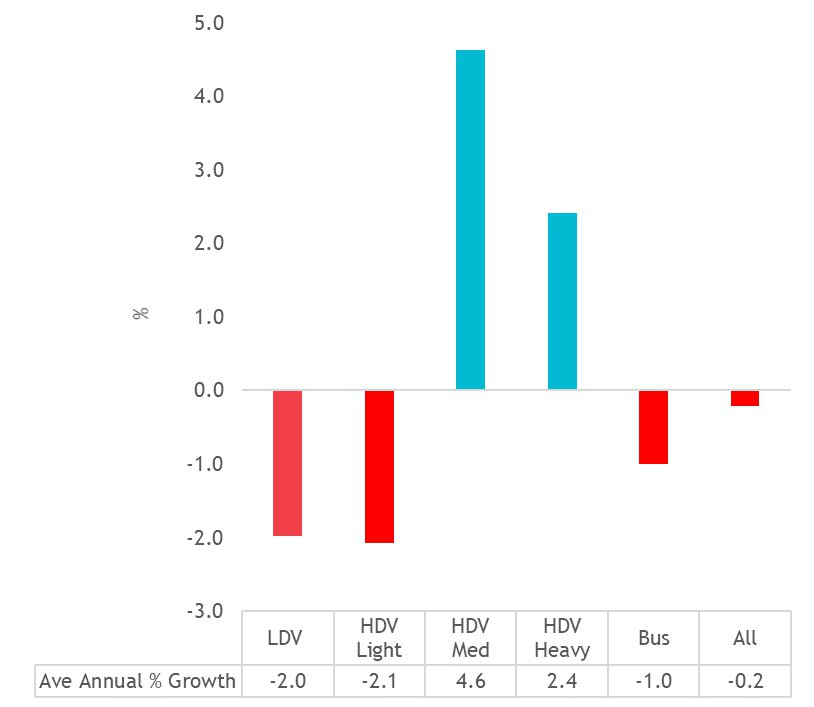
Annual Vehicle Tailpipe Emissions by State – High Electric Case
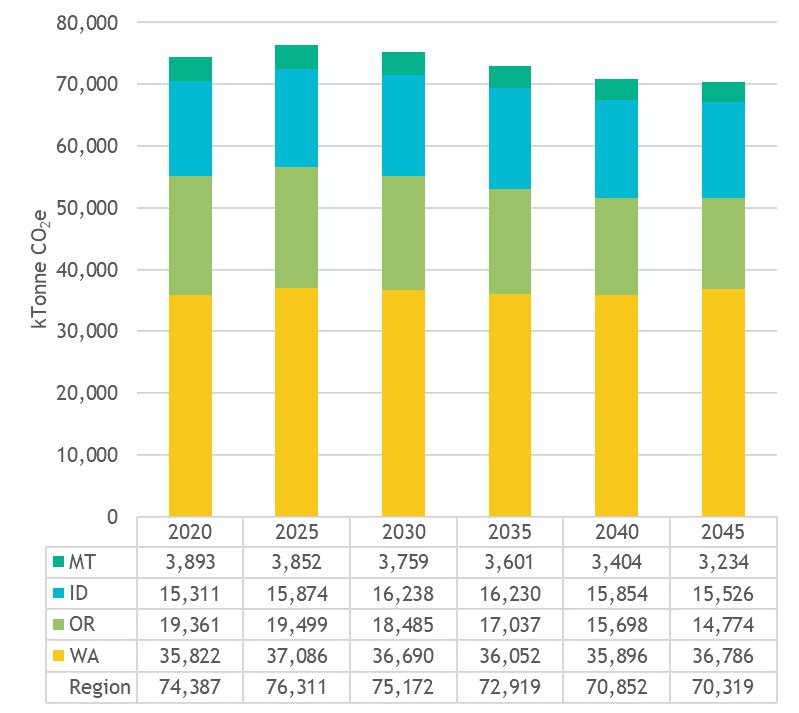
Annual Vehicle Tailpipe Emissions by Category – High Electric Case
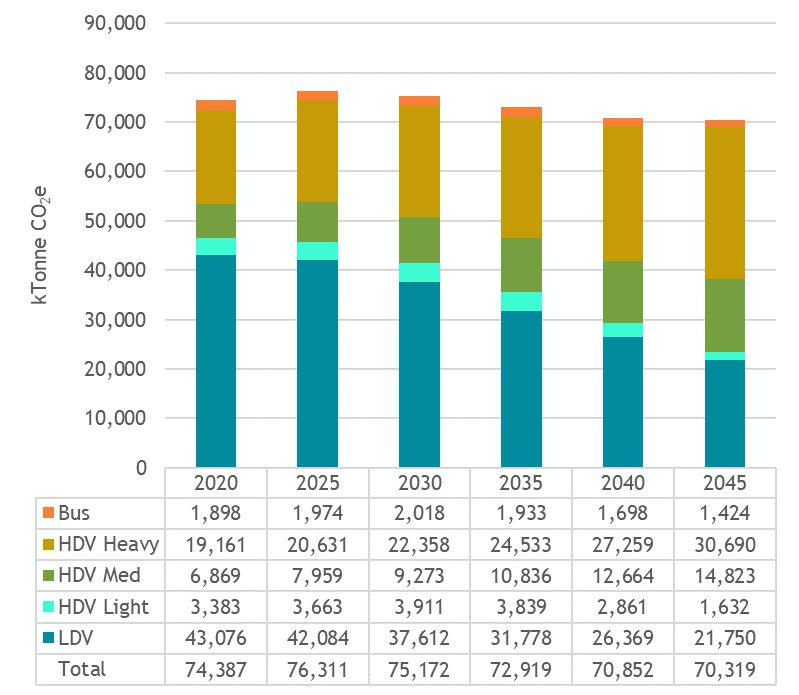
[1] Note: the indirect emissions from power generation related to electric vehicle demand are not included in this study but are included in other downstream power planning models
[2] High Electric & H2E Case only
[3] H2E Case only



